Project: Sustainable Construction in Natural Environment
VerifiedAdded on 2023/01/24
|22
|4273
|78
Project
AI Summary
This project focuses on the design and construction of a five-story apartment block in Coffs Harbour, NSW, emphasizing sustainable practices. The assignment investigates alternative materials such as hempcrete, wood, and recycled plastics to minimize environmental impact and improve human health, safety, and comfort. The project considers local climate, biome, and client requirements, proposing solutions to challenges like water intrusion and wind resistance. The decision-making process prioritizes material recyclability, the absence of hazardous ingredients, and proximity to the manufacturing site. The project evaluates materials based on their fate, health impacts, living economy sourcing, and responsible industry practices, providing a comprehensive framework for sustainable construction decisions. The project analyzes the use of recycled plastics in concrete, timber, and hempcrete, addressing the challenge of finding coherent publications about the use of recycled plastics in concrete. The project also considers the importance of eco-certification and the use of recycled materials to create a more sustainable building project.
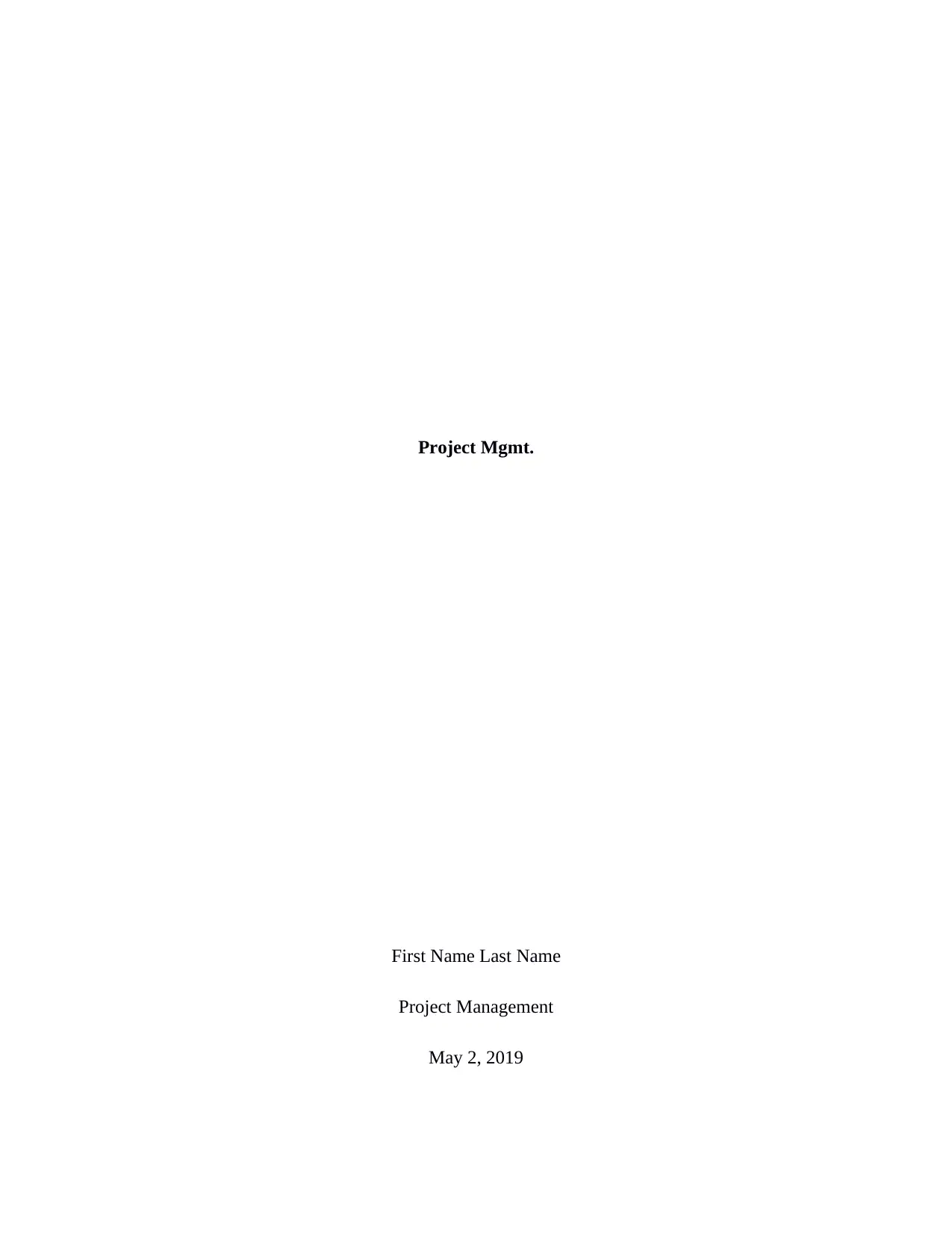
Project Mgmt.
First Name Last Name
Project Management
May 2, 2019
First Name Last Name
Project Management
May 2, 2019
Paraphrase This Document
Need a fresh take? Get an instant paraphrase of this document with our AI Paraphraser
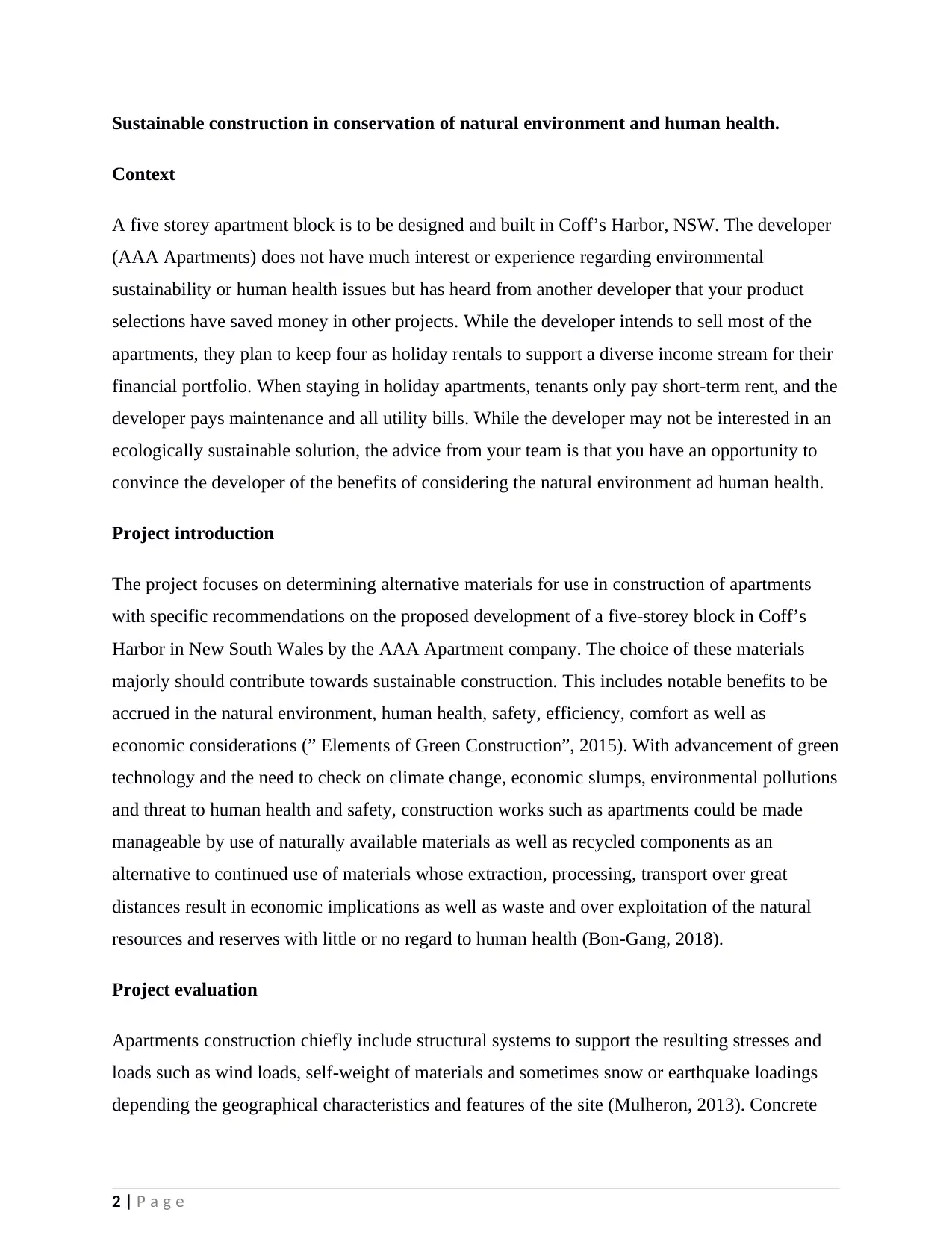
Sustainable construction in conservation of natural environment and human health.
Context
A five storey apartment block is to be designed and built in Coff’s Harbor, NSW. The developer
(AAA Apartments) does not have much interest or experience regarding environmental
sustainability or human health issues but has heard from another developer that your product
selections have saved money in other projects. While the developer intends to sell most of the
apartments, they plan to keep four as holiday rentals to support a diverse income stream for their
financial portfolio. When staying in holiday apartments, tenants only pay short-term rent, and the
developer pays maintenance and all utility bills. While the developer may not be interested in an
ecologically sustainable solution, the advice from your team is that you have an opportunity to
convince the developer of the benefits of considering the natural environment ad human health.
Project introduction
The project focuses on determining alternative materials for use in construction of apartments
with specific recommendations on the proposed development of a five-storey block in Coff’s
Harbor in New South Wales by the AAA Apartment company. The choice of these materials
majorly should contribute towards sustainable construction. This includes notable benefits to be
accrued in the natural environment, human health, safety, efficiency, comfort as well as
economic considerations (” Elements of Green Construction”, 2015). With advancement of green
technology and the need to check on climate change, economic slumps, environmental pollutions
and threat to human health and safety, construction works such as apartments could be made
manageable by use of naturally available materials as well as recycled components as an
alternative to continued use of materials whose extraction, processing, transport over great
distances result in economic implications as well as waste and over exploitation of the natural
resources and reserves with little or no regard to human health (Bon-Gang, 2018).
Project evaluation
Apartments construction chiefly include structural systems to support the resulting stresses and
loads such as wind loads, self-weight of materials and sometimes snow or earthquake loadings
depending the geographical characteristics and features of the site (Mulheron, 2013). Concrete
2 | P a g e
Context
A five storey apartment block is to be designed and built in Coff’s Harbor, NSW. The developer
(AAA Apartments) does not have much interest or experience regarding environmental
sustainability or human health issues but has heard from another developer that your product
selections have saved money in other projects. While the developer intends to sell most of the
apartments, they plan to keep four as holiday rentals to support a diverse income stream for their
financial portfolio. When staying in holiday apartments, tenants only pay short-term rent, and the
developer pays maintenance and all utility bills. While the developer may not be interested in an
ecologically sustainable solution, the advice from your team is that you have an opportunity to
convince the developer of the benefits of considering the natural environment ad human health.
Project introduction
The project focuses on determining alternative materials for use in construction of apartments
with specific recommendations on the proposed development of a five-storey block in Coff’s
Harbor in New South Wales by the AAA Apartment company. The choice of these materials
majorly should contribute towards sustainable construction. This includes notable benefits to be
accrued in the natural environment, human health, safety, efficiency, comfort as well as
economic considerations (” Elements of Green Construction”, 2015). With advancement of green
technology and the need to check on climate change, economic slumps, environmental pollutions
and threat to human health and safety, construction works such as apartments could be made
manageable by use of naturally available materials as well as recycled components as an
alternative to continued use of materials whose extraction, processing, transport over great
distances result in economic implications as well as waste and over exploitation of the natural
resources and reserves with little or no regard to human health (Bon-Gang, 2018).
Project evaluation
Apartments construction chiefly include structural systems to support the resulting stresses and
loads such as wind loads, self-weight of materials and sometimes snow or earthquake loadings
depending the geographical characteristics and features of the site (Mulheron, 2013). Concrete
2 | P a g e
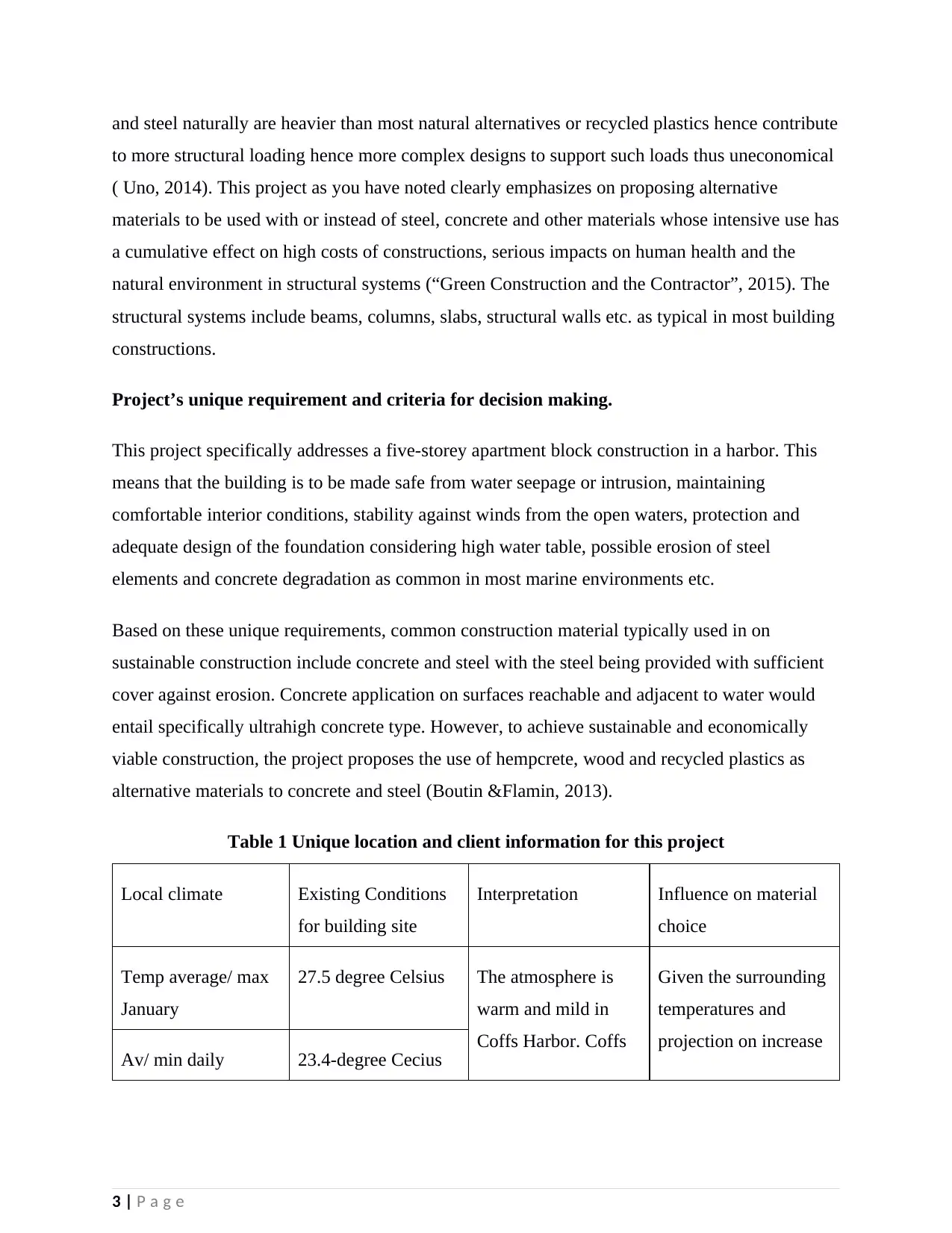
and steel naturally are heavier than most natural alternatives or recycled plastics hence contribute
to more structural loading hence more complex designs to support such loads thus uneconomical
( Uno, 2014). This project as you have noted clearly emphasizes on proposing alternative
materials to be used with or instead of steel, concrete and other materials whose intensive use has
a cumulative effect on high costs of constructions, serious impacts on human health and the
natural environment in structural systems (“Green Construction and the Contractor”, 2015). The
structural systems include beams, columns, slabs, structural walls etc. as typical in most building
constructions.
Project’s unique requirement and criteria for decision making.
This project specifically addresses a five-storey apartment block construction in a harbor. This
means that the building is to be made safe from water seepage or intrusion, maintaining
comfortable interior conditions, stability against winds from the open waters, protection and
adequate design of the foundation considering high water table, possible erosion of steel
elements and concrete degradation as common in most marine environments etc.
Based on these unique requirements, common construction material typically used in on
sustainable construction include concrete and steel with the steel being provided with sufficient
cover against erosion. Concrete application on surfaces reachable and adjacent to water would
entail specifically ultrahigh concrete type. However, to achieve sustainable and economically
viable construction, the project proposes the use of hempcrete, wood and recycled plastics as
alternative materials to concrete and steel (Boutin &Flamin, 2013).
Table 1 Unique location and client information for this project
Local climate Existing Conditions
for building site
Interpretation Influence on material
choice
Temp average/ max
January
27.5 degree Celsius The atmosphere is
warm and mild in
Coffs Harbor. Coffs
Given the surrounding
temperatures and
projection on increase
Av/ min daily 23.4-degree Cecius
3 | P a g e
to more structural loading hence more complex designs to support such loads thus uneconomical
( Uno, 2014). This project as you have noted clearly emphasizes on proposing alternative
materials to be used with or instead of steel, concrete and other materials whose intensive use has
a cumulative effect on high costs of constructions, serious impacts on human health and the
natural environment in structural systems (“Green Construction and the Contractor”, 2015). The
structural systems include beams, columns, slabs, structural walls etc. as typical in most building
constructions.
Project’s unique requirement and criteria for decision making.
This project specifically addresses a five-storey apartment block construction in a harbor. This
means that the building is to be made safe from water seepage or intrusion, maintaining
comfortable interior conditions, stability against winds from the open waters, protection and
adequate design of the foundation considering high water table, possible erosion of steel
elements and concrete degradation as common in most marine environments etc.
Based on these unique requirements, common construction material typically used in on
sustainable construction include concrete and steel with the steel being provided with sufficient
cover against erosion. Concrete application on surfaces reachable and adjacent to water would
entail specifically ultrahigh concrete type. However, to achieve sustainable and economically
viable construction, the project proposes the use of hempcrete, wood and recycled plastics as
alternative materials to concrete and steel (Boutin &Flamin, 2013).
Table 1 Unique location and client information for this project
Local climate Existing Conditions
for building site
Interpretation Influence on material
choice
Temp average/ max
January
27.5 degree Celsius The atmosphere is
warm and mild in
Coffs Harbor. Coffs
Given the surrounding
temperatures and
projection on increase
Av/ min daily 23.4-degree Cecius
3 | P a g e
⊘ This is a preview!⊘
Do you want full access?
Subscribe today to unlock all pages.

Trusted by 1+ million students worldwide
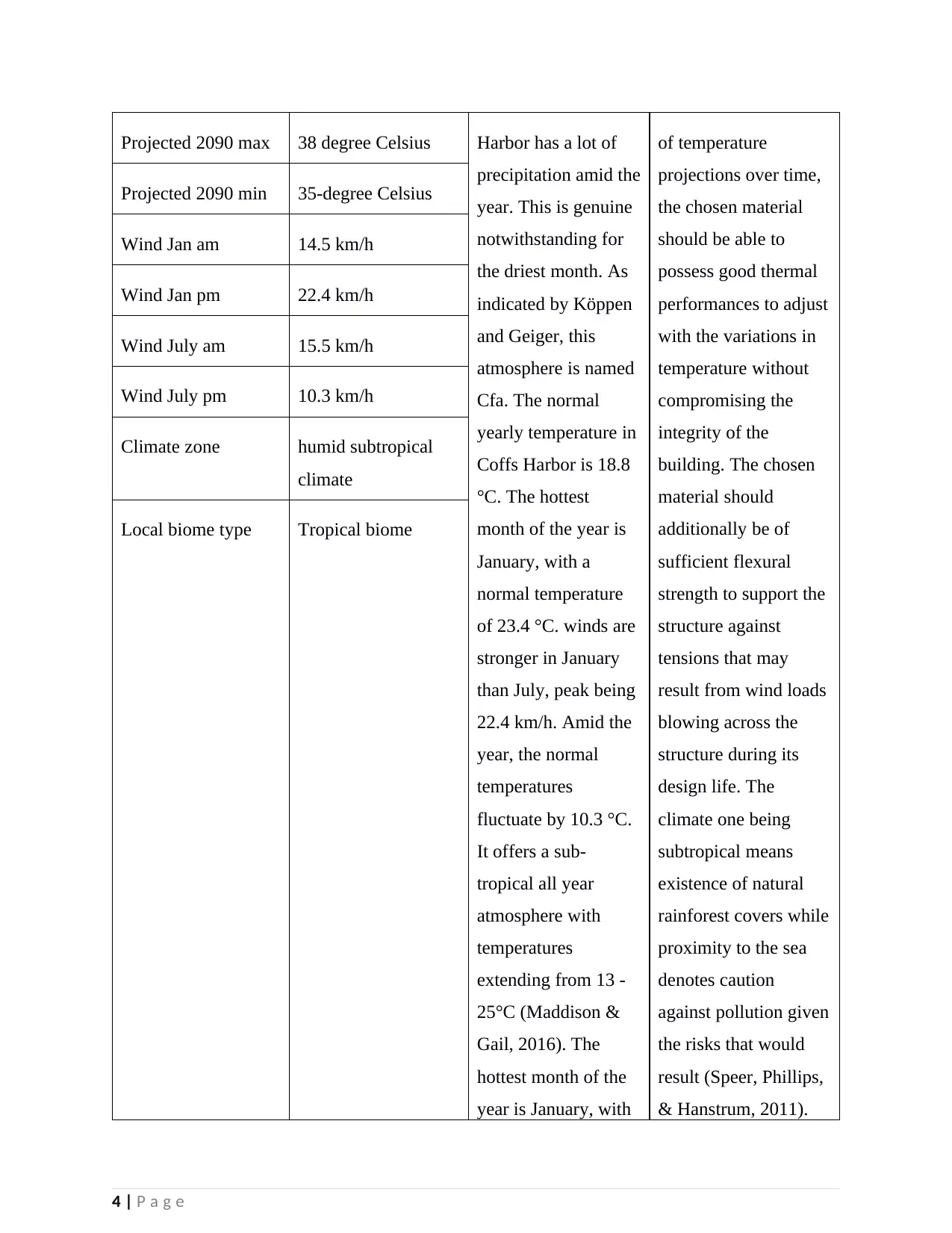
Harbor has a lot of
precipitation amid the
year. This is genuine
notwithstanding for
the driest month. As
indicated by Köppen
and Geiger, this
atmosphere is named
Cfa. The normal
yearly temperature in
Coffs Harbor is 18.8
°C. The hottest
month of the year is
January, with a
normal temperature
of 23.4 °C. winds are
stronger in January
than July, peak being
22.4 km/h. Amid the
year, the normal
temperatures
fluctuate by 10.3 °C.
It offers a sub-
tropical all year
atmosphere with
temperatures
extending from 13 -
25°C (Maddison &
Gail, 2016). The
hottest month of the
year is January, with
of temperature
projections over time,
the chosen material
should be able to
possess good thermal
performances to adjust
with the variations in
temperature without
compromising the
integrity of the
building. The chosen
material should
additionally be of
sufficient flexural
strength to support the
structure against
tensions that may
result from wind loads
blowing across the
structure during its
design life. The
climate one being
subtropical means
existence of natural
rainforest covers while
proximity to the sea
denotes caution
against pollution given
the risks that would
result (Speer, Phillips,
& Hanstrum, 2011).
Projected 2090 max 38 degree Celsius
Projected 2090 min 35-degree Celsius
Wind Jan am 14.5 km/h
Wind Jan pm 22.4 km/h
Wind July am 15.5 km/h
Wind July pm 10.3 km/h
Climate zone humid subtropical
climate
Local biome type Tropical biome
4 | P a g e
precipitation amid the
year. This is genuine
notwithstanding for
the driest month. As
indicated by Köppen
and Geiger, this
atmosphere is named
Cfa. The normal
yearly temperature in
Coffs Harbor is 18.8
°C. The hottest
month of the year is
January, with a
normal temperature
of 23.4 °C. winds are
stronger in January
than July, peak being
22.4 km/h. Amid the
year, the normal
temperatures
fluctuate by 10.3 °C.
It offers a sub-
tropical all year
atmosphere with
temperatures
extending from 13 -
25°C (Maddison &
Gail, 2016). The
hottest month of the
year is January, with
of temperature
projections over time,
the chosen material
should be able to
possess good thermal
performances to adjust
with the variations in
temperature without
compromising the
integrity of the
building. The chosen
material should
additionally be of
sufficient flexural
strength to support the
structure against
tensions that may
result from wind loads
blowing across the
structure during its
design life. The
climate one being
subtropical means
existence of natural
rainforest covers while
proximity to the sea
denotes caution
against pollution given
the risks that would
result (Speer, Phillips,
& Hanstrum, 2011).
Projected 2090 max 38 degree Celsius
Projected 2090 min 35-degree Celsius
Wind Jan am 14.5 km/h
Wind Jan pm 22.4 km/h
Wind July am 15.5 km/h
Wind July pm 10.3 km/h
Climate zone humid subtropical
climate
Local biome type Tropical biome
4 | P a g e
Paraphrase This Document
Need a fresh take? Get an instant paraphrase of this document with our AI Paraphraser
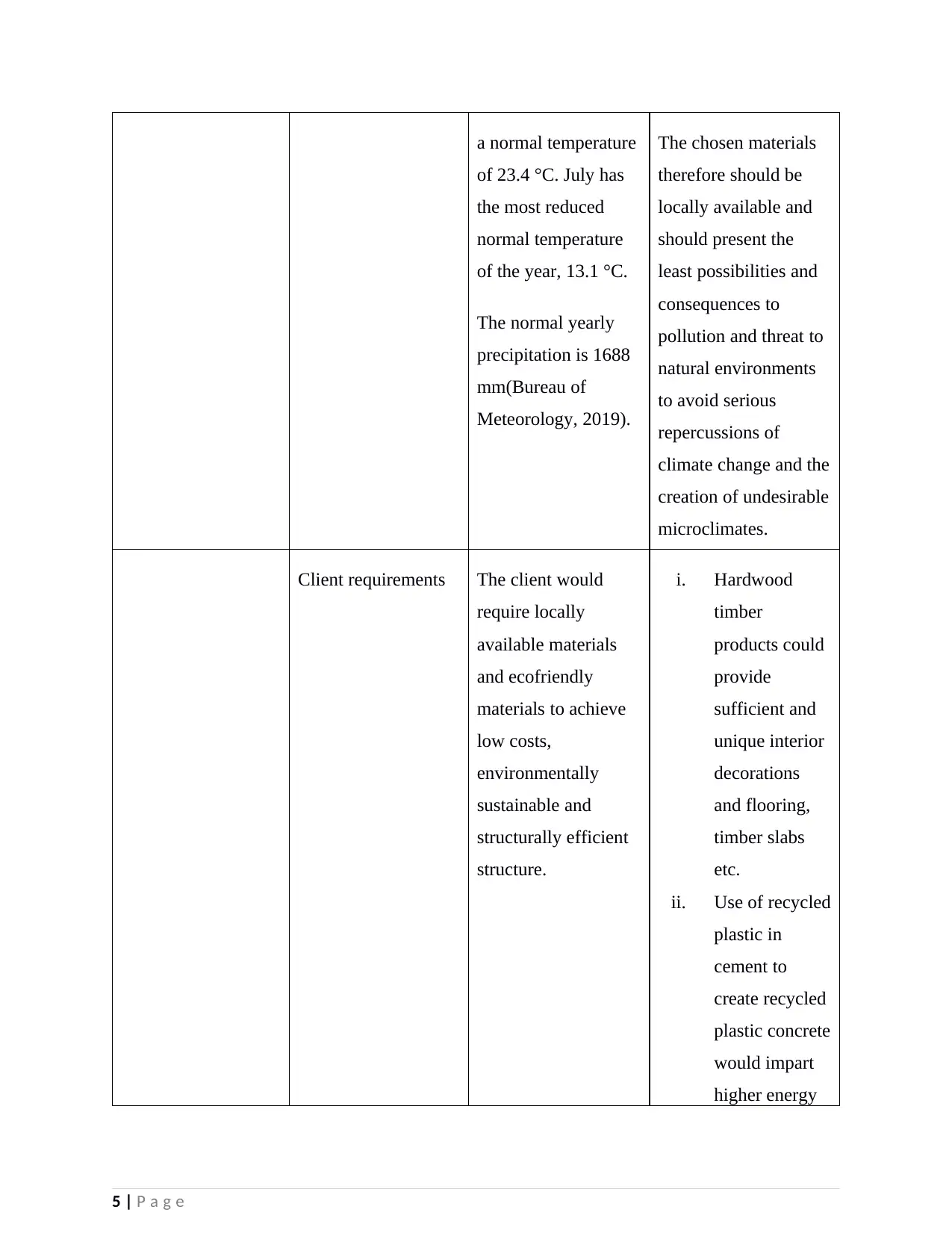
a normal temperature
of 23.4 °C. July has
the most reduced
normal temperature
of the year, 13.1 °C.
The normal yearly
precipitation is 1688
mm(Bureau of
Meteorology, 2019).
The chosen materials
therefore should be
locally available and
should present the
least possibilities and
consequences to
pollution and threat to
natural environments
to avoid serious
repercussions of
climate change and the
creation of undesirable
microclimates.
Client requirements The client would
require locally
available materials
and ecofriendly
materials to achieve
low costs,
environmentally
sustainable and
structurally efficient
structure.
i. Hardwood
timber
products could
provide
sufficient and
unique interior
decorations
and flooring,
timber slabs
etc.
ii. Use of recycled
plastic in
cement to
create recycled
plastic concrete
would impart
higher energy
5 | P a g e
of 23.4 °C. July has
the most reduced
normal temperature
of the year, 13.1 °C.
The normal yearly
precipitation is 1688
mm(Bureau of
Meteorology, 2019).
The chosen materials
therefore should be
locally available and
should present the
least possibilities and
consequences to
pollution and threat to
natural environments
to avoid serious
repercussions of
climate change and the
creation of undesirable
microclimates.
Client requirements The client would
require locally
available materials
and ecofriendly
materials to achieve
low costs,
environmentally
sustainable and
structurally efficient
structure.
i. Hardwood
timber
products could
provide
sufficient and
unique interior
decorations
and flooring,
timber slabs
etc.
ii. Use of recycled
plastic in
cement to
create recycled
plastic concrete
would impart
higher energy
5 | P a g e
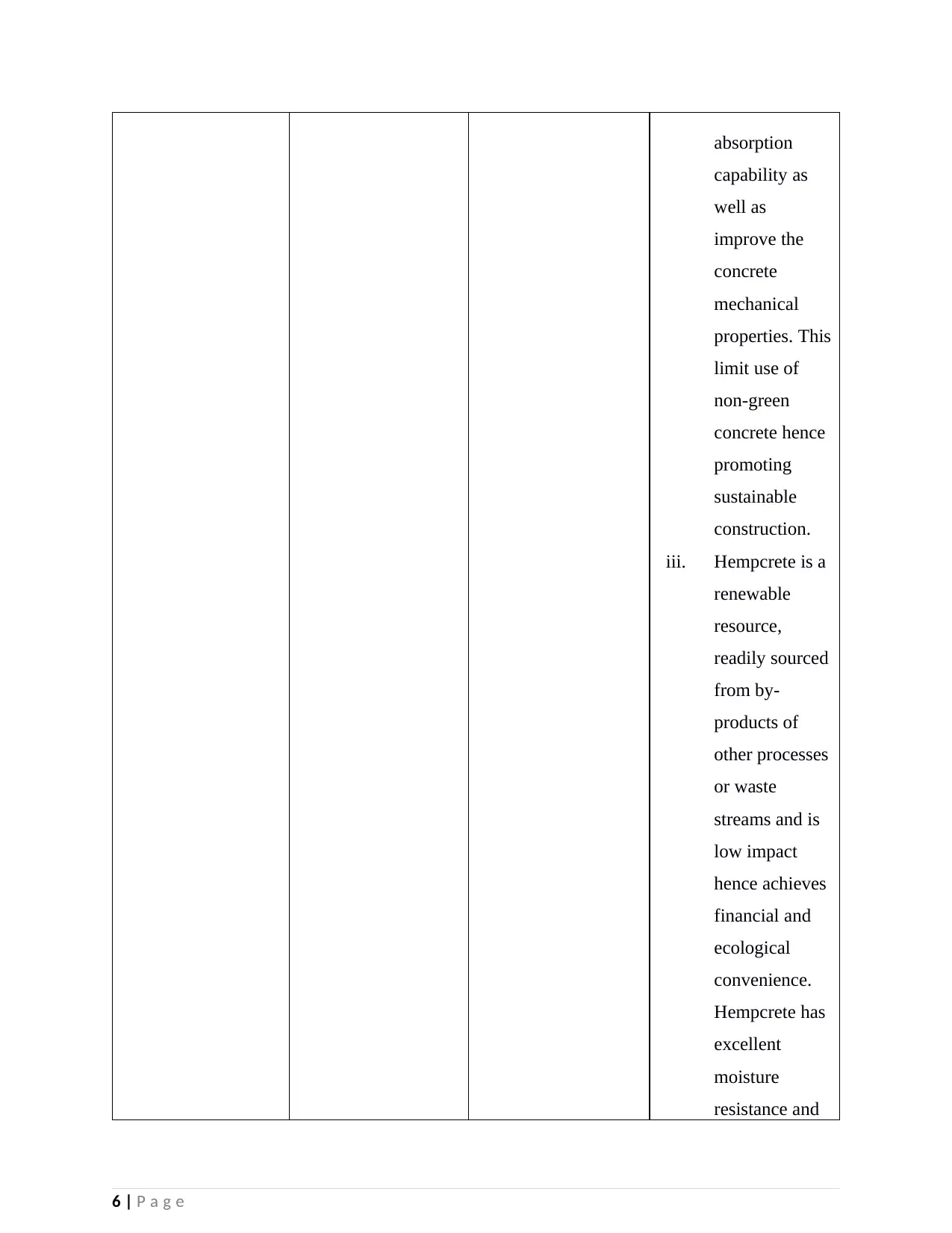
absorption
capability as
well as
improve the
concrete
mechanical
properties. This
limit use of
non-green
concrete hence
promoting
sustainable
construction.
iii. Hempcrete is a
renewable
resource,
readily sourced
from by-
products of
other processes
or waste
streams and is
low impact
hence achieves
financial and
ecological
convenience.
Hempcrete has
excellent
moisture
resistance and
6 | P a g e
capability as
well as
improve the
concrete
mechanical
properties. This
limit use of
non-green
concrete hence
promoting
sustainable
construction.
iii. Hempcrete is a
renewable
resource,
readily sourced
from by-
products of
other processes
or waste
streams and is
low impact
hence achieves
financial and
ecological
convenience.
Hempcrete has
excellent
moisture
resistance and
6 | P a g e
⊘ This is a preview!⊘
Do you want full access?
Subscribe today to unlock all pages.

Trusted by 1+ million students worldwide
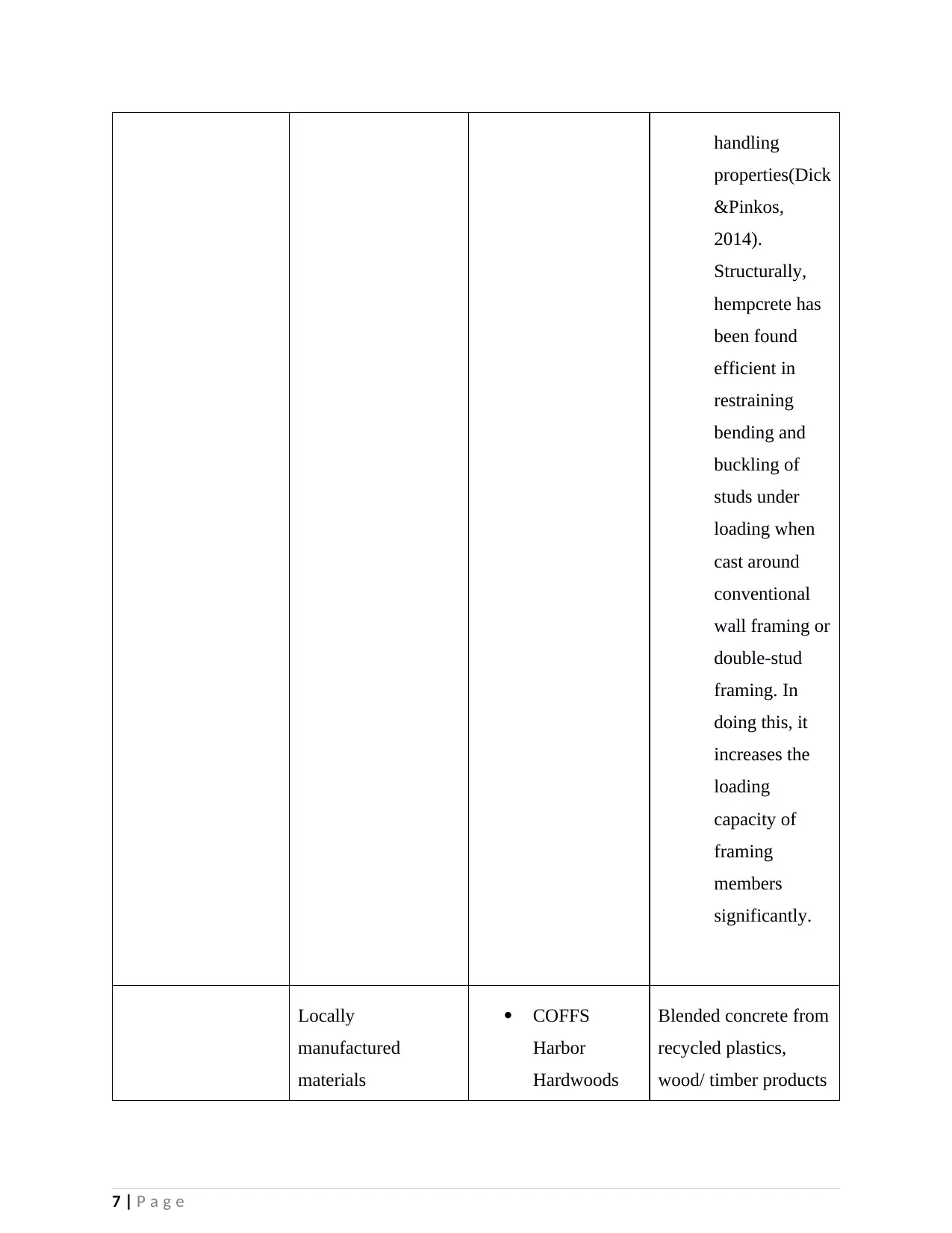
handling
properties(Dick
&Pinkos,
2014).
Structurally,
hempcrete has
been found
efficient in
restraining
bending and
buckling of
studs under
loading when
cast around
conventional
wall framing or
double-stud
framing. In
doing this, it
increases the
loading
capacity of
framing
members
significantly.
Locally
manufactured
materials
COFFS
Harbor
Hardwoods
Blended concrete from
recycled plastics,
wood/ timber products
7 | P a g e
properties(Dick
&Pinkos,
2014).
Structurally,
hempcrete has
been found
efficient in
restraining
bending and
buckling of
studs under
loading when
cast around
conventional
wall framing or
double-stud
framing. In
doing this, it
increases the
loading
capacity of
framing
members
significantly.
Locally
manufactured
materials
COFFS
Harbor
Hardwoods
Blended concrete from
recycled plastics,
wood/ timber products
7 | P a g e
Paraphrase This Document
Need a fresh take? Get an instant paraphrase of this document with our AI Paraphraser
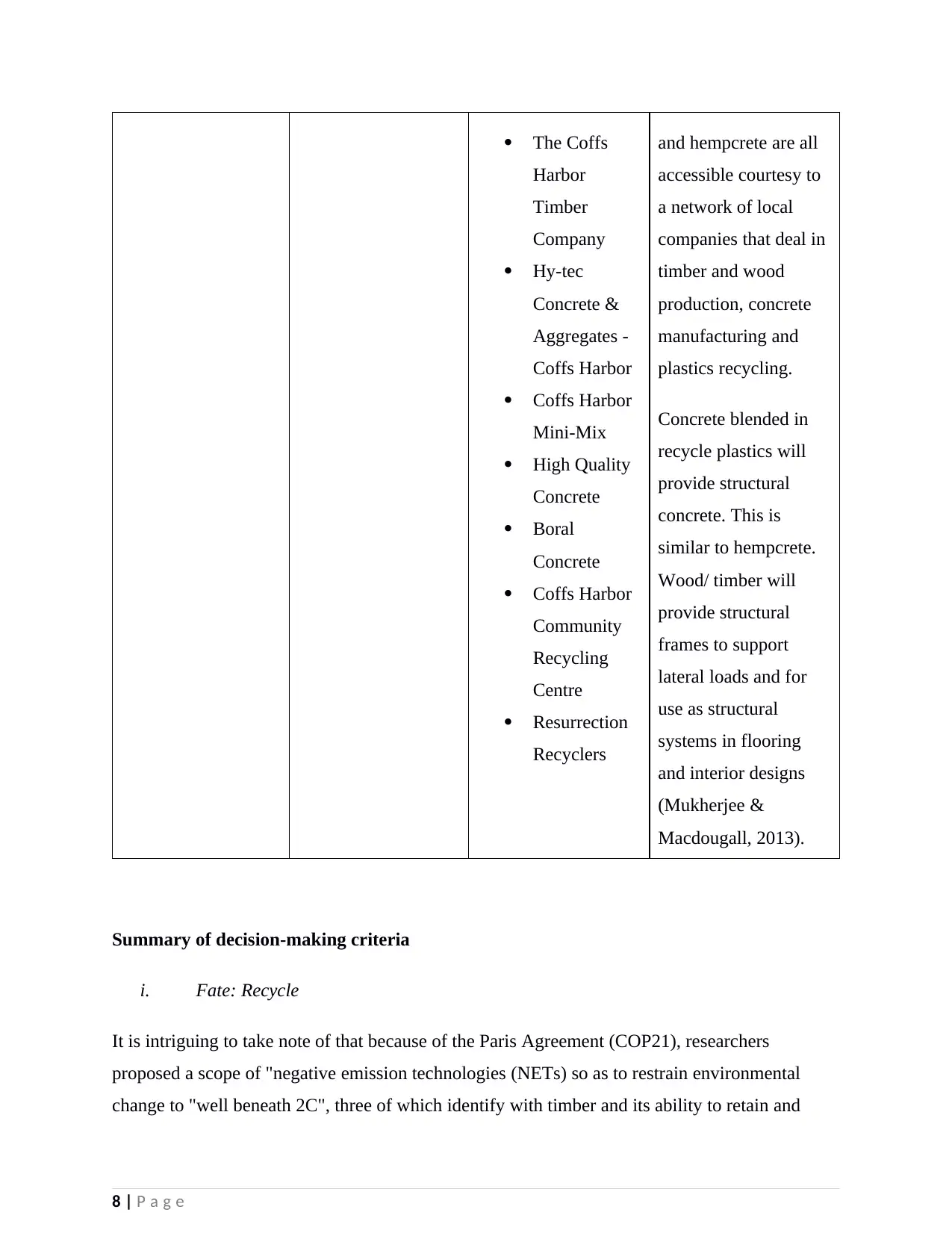
The Coffs
Harbor
Timber
Company
Hy-tec
Concrete &
Aggregates -
Coffs Harbor
Coffs Harbor
Mini-Mix
High Quality
Concrete
Boral
Concrete
Coffs Harbor
Community
Recycling
Centre
Resurrection
Recyclers
and hempcrete are all
accessible courtesy to
a network of local
companies that deal in
timber and wood
production, concrete
manufacturing and
plastics recycling.
Concrete blended in
recycle plastics will
provide structural
concrete. This is
similar to hempcrete.
Wood/ timber will
provide structural
frames to support
lateral loads and for
use as structural
systems in flooring
and interior designs
(Mukherjee &
Macdougall, 2013).
Summary of decision-making criteria
i. Fate: Recycle
It is intriguing to take note of that because of the Paris Agreement (COP21), researchers
proposed a scope of "negative emission technologies (NETs) so as to restrain environmental
change to "well beneath 2C", three of which identify with timber and its ability to retain and
8 | P a g e
Harbor
Timber
Company
Hy-tec
Concrete &
Aggregates -
Coffs Harbor
Coffs Harbor
Mini-Mix
High Quality
Concrete
Boral
Concrete
Coffs Harbor
Community
Recycling
Centre
Resurrection
Recyclers
and hempcrete are all
accessible courtesy to
a network of local
companies that deal in
timber and wood
production, concrete
manufacturing and
plastics recycling.
Concrete blended in
recycle plastics will
provide structural
concrete. This is
similar to hempcrete.
Wood/ timber will
provide structural
frames to support
lateral loads and for
use as structural
systems in flooring
and interior designs
(Mukherjee &
Macdougall, 2013).
Summary of decision-making criteria
i. Fate: Recycle
It is intriguing to take note of that because of the Paris Agreement (COP21), researchers
proposed a scope of "negative emission technologies (NETs) so as to restrain environmental
change to "well beneath 2C", three of which identify with timber and its ability to retain and
8 | P a g e
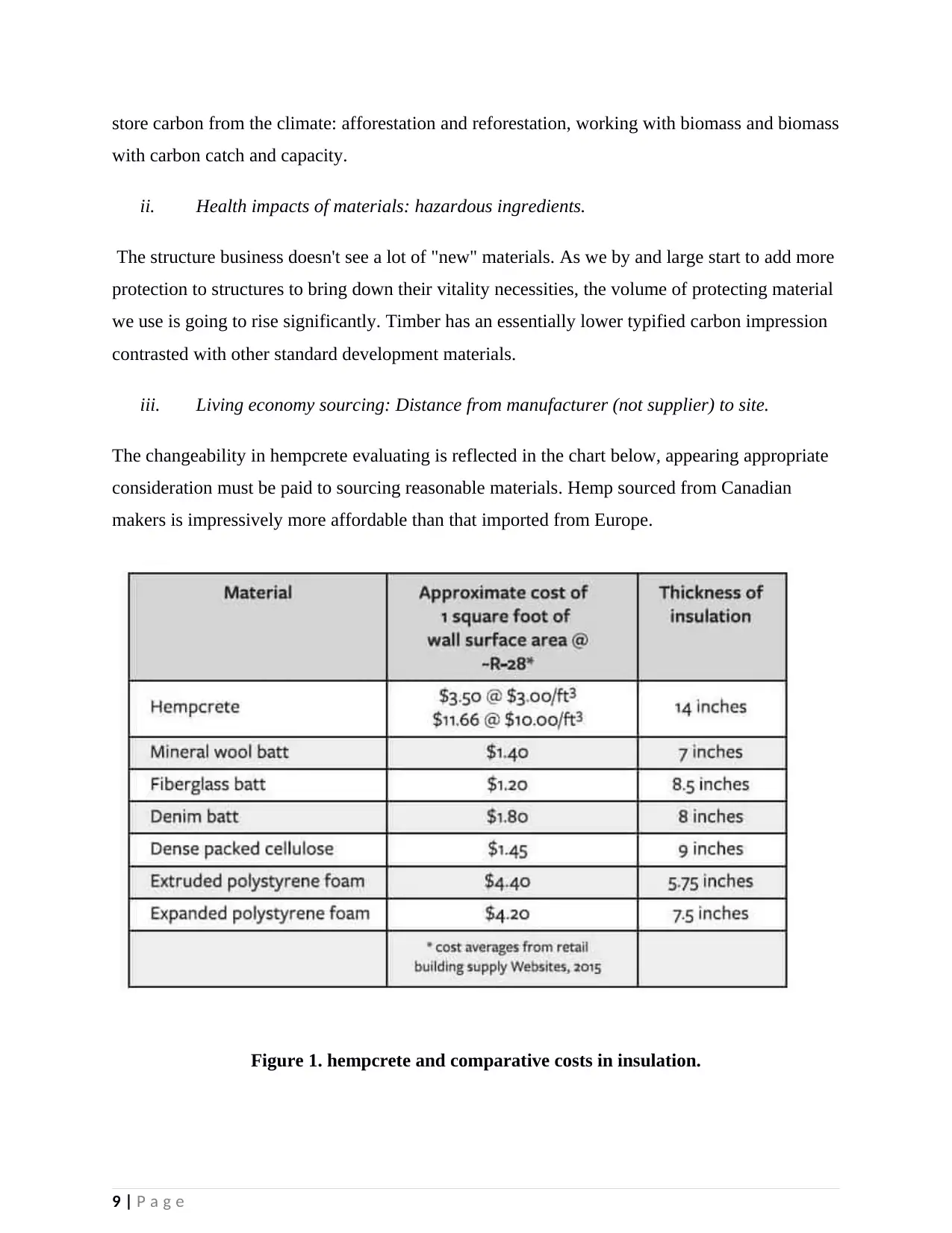
store carbon from the climate: afforestation and reforestation, working with biomass and biomass
with carbon catch and capacity.
ii. Health impacts of materials: hazardous ingredients.
The structure business doesn't see a lot of "new" materials. As we by and large start to add more
protection to structures to bring down their vitality necessities, the volume of protecting material
we use is going to rise significantly. Timber has an essentially lower typified carbon impression
contrasted with other standard development materials.
iii. Living economy sourcing: Distance from manufacturer (not supplier) to site.
The changeability in hempcrete evaluating is reflected in the chart below, appearing appropriate
consideration must be paid to sourcing reasonable materials. Hemp sourced from Canadian
makers is impressively more affordable than that imported from Europe.
Figure 1. hempcrete and comparative costs in insulation.
9 | P a g e
with carbon catch and capacity.
ii. Health impacts of materials: hazardous ingredients.
The structure business doesn't see a lot of "new" materials. As we by and large start to add more
protection to structures to bring down their vitality necessities, the volume of protecting material
we use is going to rise significantly. Timber has an essentially lower typified carbon impression
contrasted with other standard development materials.
iii. Living economy sourcing: Distance from manufacturer (not supplier) to site.
The changeability in hempcrete evaluating is reflected in the chart below, appearing appropriate
consideration must be paid to sourcing reasonable materials. Hemp sourced from Canadian
makers is impressively more affordable than that imported from Europe.
Figure 1. hempcrete and comparative costs in insulation.
9 | P a g e
⊘ This is a preview!⊘
Do you want full access?
Subscribe today to unlock all pages.

Trusted by 1+ million students worldwide
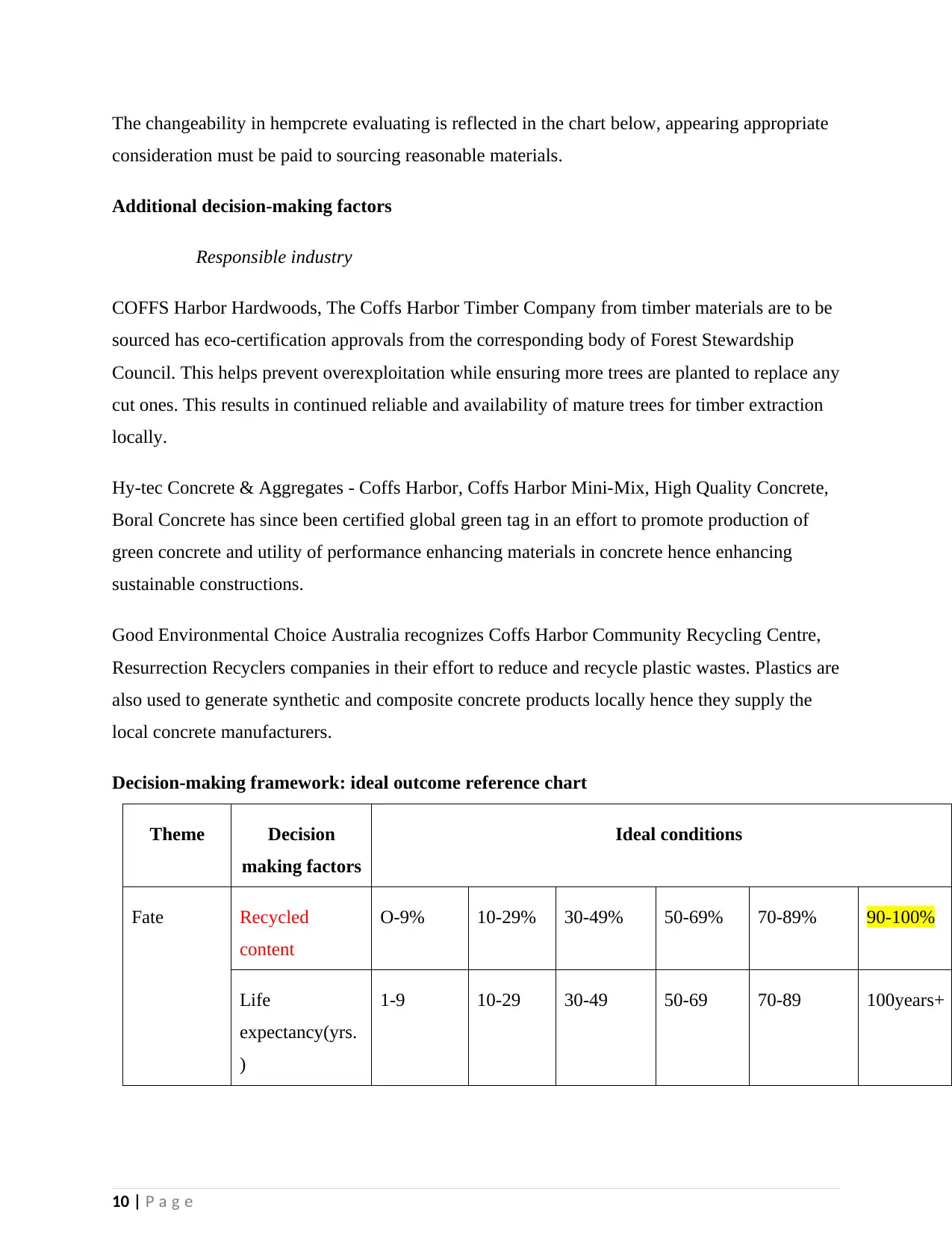
The changeability in hempcrete evaluating is reflected in the chart below, appearing appropriate
consideration must be paid to sourcing reasonable materials.
Additional decision-making factors
Responsible industry
COFFS Harbor Hardwoods, The Coffs Harbor Timber Company from timber materials are to be
sourced has eco-certification approvals from the corresponding body of Forest Stewardship
Council. This helps prevent overexploitation while ensuring more trees are planted to replace any
cut ones. This results in continued reliable and availability of mature trees for timber extraction
locally.
Hy-tec Concrete & Aggregates - Coffs Harbor, Coffs Harbor Mini-Mix, High Quality Concrete,
Boral Concrete has since been certified global green tag in an effort to promote production of
green concrete and utility of performance enhancing materials in concrete hence enhancing
sustainable constructions.
Good Environmental Choice Australia recognizes Coffs Harbor Community Recycling Centre,
Resurrection Recyclers companies in their effort to reduce and recycle plastic wastes. Plastics are
also used to generate synthetic and composite concrete products locally hence they supply the
local concrete manufacturers.
Decision-making framework: ideal outcome reference chart
Theme Decision
making factors
Ideal conditions
Fate Recycled
content
O-9% 10-29% 30-49% 50-69% 70-89% 90-100%
Life
expectancy(yrs.
)
1-9 10-29 30-49 50-69 70-89 100years+
10 | P a g e
consideration must be paid to sourcing reasonable materials.
Additional decision-making factors
Responsible industry
COFFS Harbor Hardwoods, The Coffs Harbor Timber Company from timber materials are to be
sourced has eco-certification approvals from the corresponding body of Forest Stewardship
Council. This helps prevent overexploitation while ensuring more trees are planted to replace any
cut ones. This results in continued reliable and availability of mature trees for timber extraction
locally.
Hy-tec Concrete & Aggregates - Coffs Harbor, Coffs Harbor Mini-Mix, High Quality Concrete,
Boral Concrete has since been certified global green tag in an effort to promote production of
green concrete and utility of performance enhancing materials in concrete hence enhancing
sustainable constructions.
Good Environmental Choice Australia recognizes Coffs Harbor Community Recycling Centre,
Resurrection Recyclers companies in their effort to reduce and recycle plastic wastes. Plastics are
also used to generate synthetic and composite concrete products locally hence they supply the
local concrete manufacturers.
Decision-making framework: ideal outcome reference chart
Theme Decision
making factors
Ideal conditions
Fate Recycled
content
O-9% 10-29% 30-49% 50-69% 70-89% 90-100%
Life
expectancy(yrs.
)
1-9 10-29 30-49 50-69 70-89 100years+
10 | P a g e
Paraphrase This Document
Need a fresh take? Get an instant paraphrase of this document with our AI Paraphraser
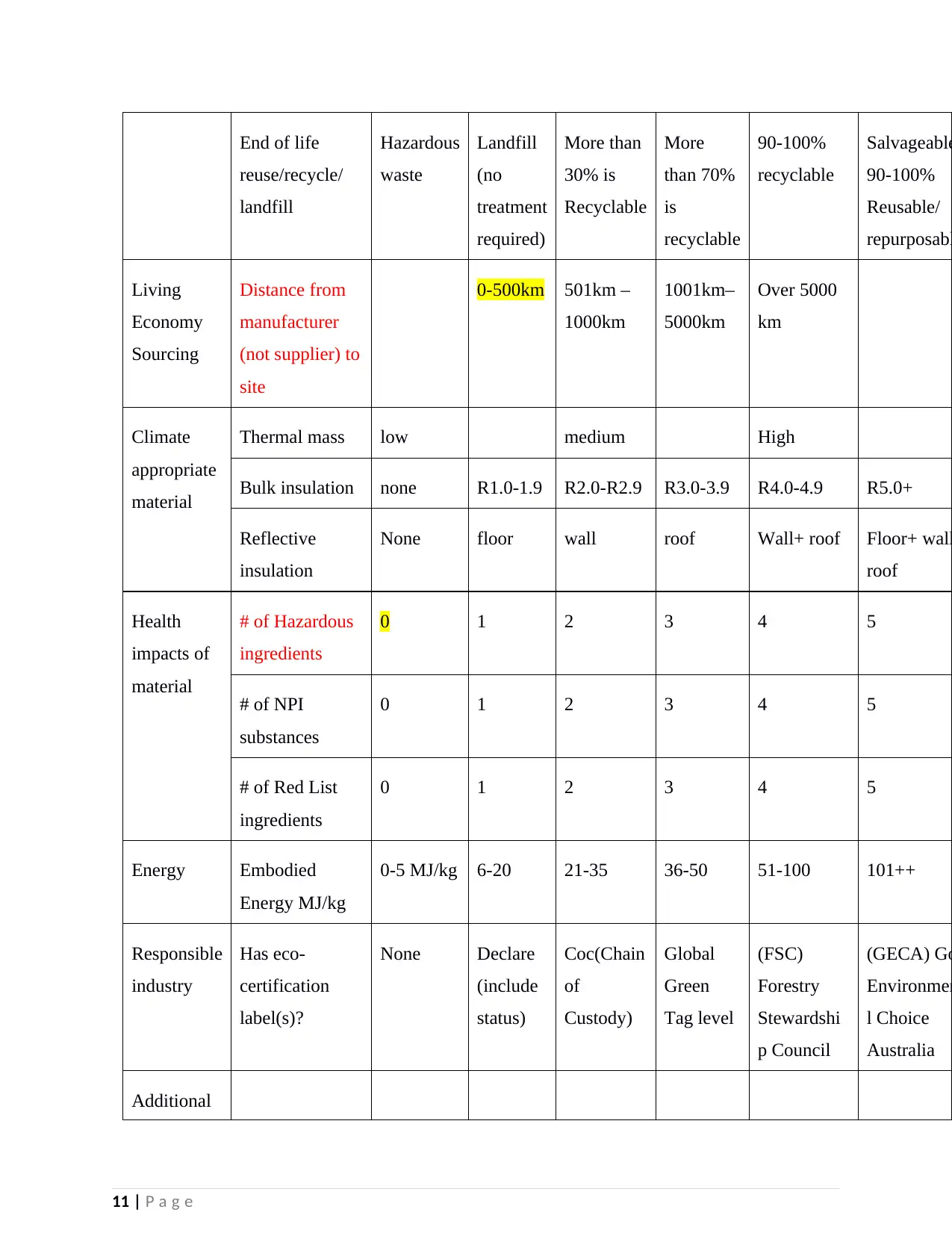
End of life
reuse/recycle/
landfill
Hazardous
waste
Landfill
(no
treatment
required)
More than
30% is
Recyclable
More
than 70%
is
recyclable
90-100%
recyclable
Salvageable
90-100%
Reusable/
repurposabl
Living
Economy
Sourcing
Distance from
manufacturer
(not supplier) to
site
0-500km 501km –
1000km
1001km–
5000km
Over 5000
km
Climate
appropriate
material
Thermal mass low medium High
Bulk insulation none R1.0-1.9 R2.0-R2.9 R3.0-3.9 R4.0-4.9 R5.0+
Reflective
insulation
None floor wall roof Wall+ roof Floor+ wall
roof
Health
impacts of
material
# of Hazardous
ingredients
0 1 2 3 4 5
# of NPI
substances
0 1 2 3 4 5
# of Red List
ingredients
0 1 2 3 4 5
Energy Embodied
Energy MJ/kg
0-5 MJ/kg 6-20 21-35 36-50 51-100 101++
Responsible
industry
Has eco-
certification
label(s)?
None Declare
(include
status)
Coc(Chain
of
Custody)
Global
Green
Tag level
(FSC)
Forestry
Stewardshi
p Council
(GECA) Go
Environmen
l Choice
Australia
Additional
11 | P a g e
reuse/recycle/
landfill
Hazardous
waste
Landfill
(no
treatment
required)
More than
30% is
Recyclable
More
than 70%
is
recyclable
90-100%
recyclable
Salvageable
90-100%
Reusable/
repurposabl
Living
Economy
Sourcing
Distance from
manufacturer
(not supplier) to
site
0-500km 501km –
1000km
1001km–
5000km
Over 5000
km
Climate
appropriate
material
Thermal mass low medium High
Bulk insulation none R1.0-1.9 R2.0-R2.9 R3.0-3.9 R4.0-4.9 R5.0+
Reflective
insulation
None floor wall roof Wall+ roof Floor+ wall
roof
Health
impacts of
material
# of Hazardous
ingredients
0 1 2 3 4 5
# of NPI
substances
0 1 2 3 4 5
# of Red List
ingredients
0 1 2 3 4 5
Energy Embodied
Energy MJ/kg
0-5 MJ/kg 6-20 21-35 36-50 51-100 101++
Responsible
industry
Has eco-
certification
label(s)?
None Declare
(include
status)
Coc(Chain
of
Custody)
Global
Green
Tag level
(FSC)
Forestry
Stewardshi
p Council
(GECA) Go
Environmen
l Choice
Australia
Additional
11 | P a g e
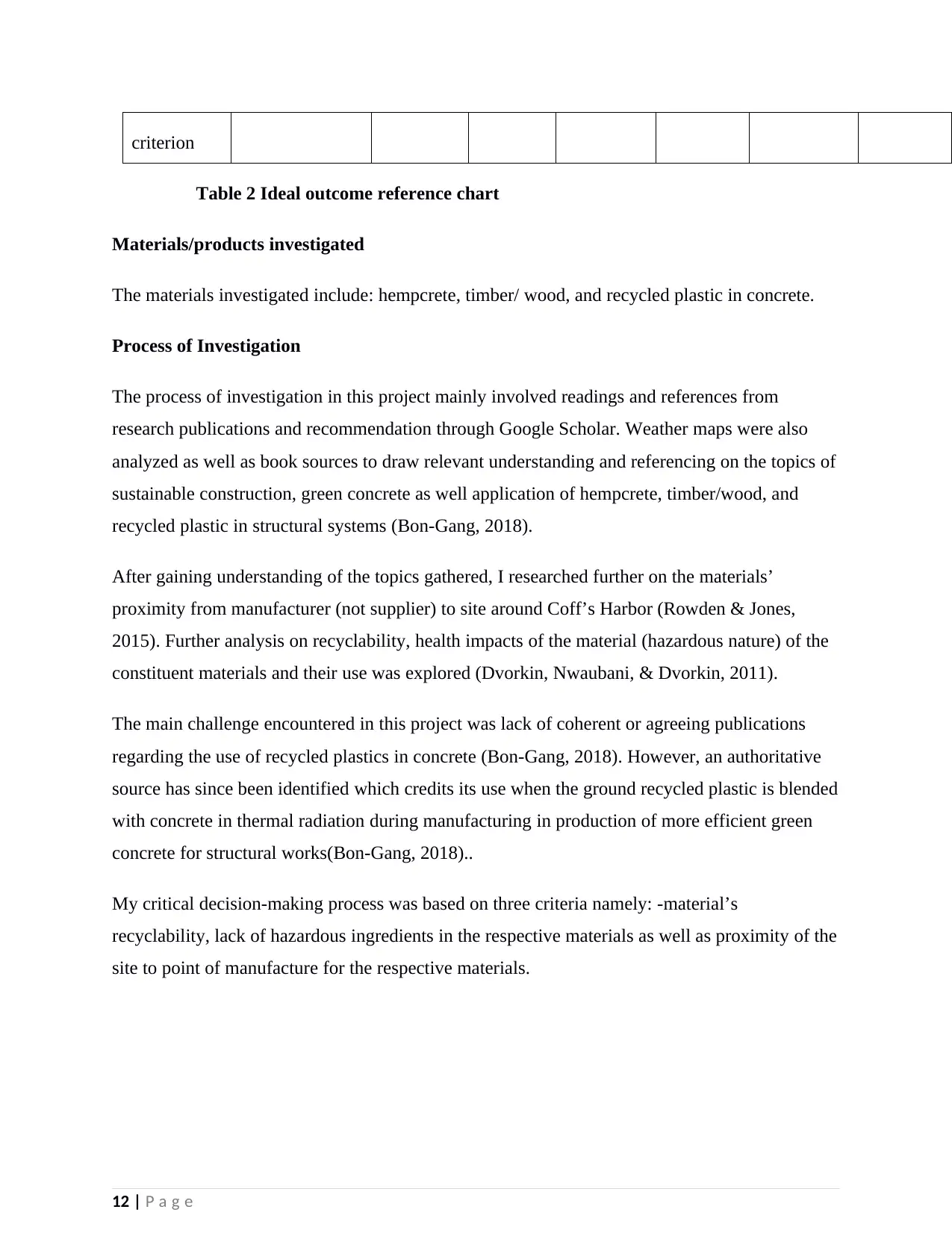
criterion
Table 2 Ideal outcome reference chart
Materials/products investigated
The materials investigated include: hempcrete, timber/ wood, and recycled plastic in concrete.
Process of Investigation
The process of investigation in this project mainly involved readings and references from
research publications and recommendation through Google Scholar. Weather maps were also
analyzed as well as book sources to draw relevant understanding and referencing on the topics of
sustainable construction, green concrete as well application of hempcrete, timber/wood, and
recycled plastic in structural systems (Bon-Gang, 2018).
After gaining understanding of the topics gathered, I researched further on the materials’
proximity from manufacturer (not supplier) to site around Coff’s Harbor (Rowden & Jones,
2015). Further analysis on recyclability, health impacts of the material (hazardous nature) of the
constituent materials and their use was explored (Dvorkin, Nwaubani, & Dvorkin, 2011).
The main challenge encountered in this project was lack of coherent or agreeing publications
regarding the use of recycled plastics in concrete (Bon-Gang, 2018). However, an authoritative
source has since been identified which credits its use when the ground recycled plastic is blended
with concrete in thermal radiation during manufacturing in production of more efficient green
concrete for structural works(Bon-Gang, 2018)..
My critical decision-making process was based on three criteria namely: -material’s
recyclability, lack of hazardous ingredients in the respective materials as well as proximity of the
site to point of manufacture for the respective materials.
12 | P a g e
Table 2 Ideal outcome reference chart
Materials/products investigated
The materials investigated include: hempcrete, timber/ wood, and recycled plastic in concrete.
Process of Investigation
The process of investigation in this project mainly involved readings and references from
research publications and recommendation through Google Scholar. Weather maps were also
analyzed as well as book sources to draw relevant understanding and referencing on the topics of
sustainable construction, green concrete as well application of hempcrete, timber/wood, and
recycled plastic in structural systems (Bon-Gang, 2018).
After gaining understanding of the topics gathered, I researched further on the materials’
proximity from manufacturer (not supplier) to site around Coff’s Harbor (Rowden & Jones,
2015). Further analysis on recyclability, health impacts of the material (hazardous nature) of the
constituent materials and their use was explored (Dvorkin, Nwaubani, & Dvorkin, 2011).
The main challenge encountered in this project was lack of coherent or agreeing publications
regarding the use of recycled plastics in concrete (Bon-Gang, 2018). However, an authoritative
source has since been identified which credits its use when the ground recycled plastic is blended
with concrete in thermal radiation during manufacturing in production of more efficient green
concrete for structural works(Bon-Gang, 2018)..
My critical decision-making process was based on three criteria namely: -material’s
recyclability, lack of hazardous ingredients in the respective materials as well as proximity of the
site to point of manufacture for the respective materials.
12 | P a g e
⊘ This is a preview!⊘
Do you want full access?
Subscribe today to unlock all pages.

Trusted by 1+ million students worldwide
1 out of 22
Related Documents
Your All-in-One AI-Powered Toolkit for Academic Success.
+13062052269
info@desklib.com
Available 24*7 on WhatsApp / Email
![[object Object]](/_next/static/media/star-bottom.7253800d.svg)
Unlock your academic potential
Copyright © 2020–2025 A2Z Services. All Rights Reserved. Developed and managed by ZUCOL.



